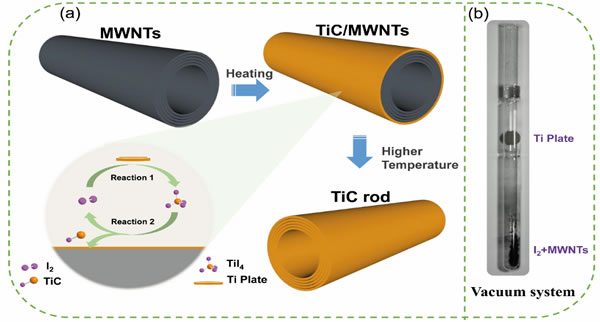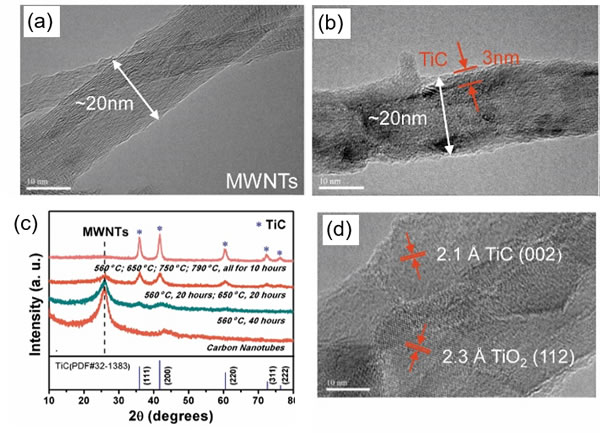At present, carbon materials including porous carbon, carbon nanotubes, and graphene are commonly used as positive electrode carriers in the research of secondary lithium-oxygen batteries. The advantages of carbon materials are: light weight, large specific surface area, high electronic conductivity, which is conducive to three-phase electrode reactions; rich in resources, simple sources, and easy to implement industrial applications. However, in the research field of non-aqueous lithium-oxygen batteries, carbon materials have problems such as insufficient stability. The non-aqueous lithium-oxygen battery undergoes a 1 electron or 2 electron oxygen reduction reaction during the discharge process, generating superoxide or lithium superoxide intermediate products with strong oxidizability, severely oxidizing carbon materials and promoting electrolyte decomposition, generating large amounts of lithium carbonate and By-products such as lithium carboxylate lead to electrode passivation and battery capacity decay. Therefore, improving the oxidation resistance and electrochemical stability of the carbon-based positive electrode is the basic element for solving such problems.
Recently, the team of Zhang Tao, a researcher at the Shanghai Institute of Ceramics, Chinese Academy of Sciences, proposed the idea of ​​combining a carbon skeleton with an ultra-thin non-carbon skin layer to develop a stable carbon-based composite positive electrode carrier. The research team used multi-walled carbon nanotubes, metal titanium powder and iodine as raw materials, and controlled the reaction degree of sp2 hybridized carbon layer on the surface of multi-walled carbon nanotubes by vapor-phase epitaxial growth method. Form a TiC surface layer. By adjusting the reaction temperature and time, the thickness of the surface layer can be precisely controlled within a few nanometers to ten nanometers. This method is universal and can be extended to carbon materials such as graphene and conductive carbon black. This carbon / non-carbon composite material improves the stability of the positive electrode of a lithium-oxygen battery to O2- and reduces the formation of by-product Li2CO3. By loading Ru nanoparticles on the composite carrier as a catalyst, the battery showed good cycle stability. Related work was published in the Energy Storage Materials academic journal Energy 2020 (2020, DOI: 10.1016 / j.ensm.2020.04.018) with the title of Inward growth of superthin TiC skin on carbon nanotube framework as stable cathode support for Li-O2 bateries . The first author of the paper is Yang Chushu, a PhD student at Shanghai Silicate, and his tutor is Zhang Tao.
Recently, the team of Zhang Tao has made a series of progress in the design and stability of air cathode carrier materials for lithium-oxygen batteries. For example, the selection of a wide range of plant bast tissues as the air cathode, the diameter and diameter of the graded porous microsieve transformed during the discharge process The size ratio of lithium peroxide is 6: 1, which can provide sufficient storage space for lithium peroxide and improve the cycle stability (Green Chemistry, 2020, 22, 388-396); In addition, the team proposed a non-oxidation strategy, at the carbon anode The ultra-thin lithium fluoride surface layer is built on the surface to improve the cycle stability of the lithium-oxygen battery. Different from the commonly used method for separate protection of positive and negative electrodes of lithium-oxygen batteries, before the battery cycle test, through a non-oxidation to electrochemical treatment, a protective layer rich in lithium fluoride is formed on the surface of the positive and negative electrodes at the same time. When the battery is working, the ultra-thin protective layer on the positive electrode side can effectively suppress the attack of superoxide on the carbon material, and the thick protective layer on the lithium negative electrode side can effectively block the corrosion of the lithium negative electrode by the electrolyte. With this in-situ protection method, the cycle stability of the lithium-oxygen battery is greatly improved. This work for the first time combines the commonly used formation technology of energy storage batteries with lithium oxygen batteries to improve the stability of active materials. It has applied for a Chinese invention patent, application number .1, and has good application prospects (Energy Storage Matierals, 2019, 23, 670 677).
Related research work was supported by the National Natural Science Foundation of China, the Chinese Academy of Sciences and the Shanghai Municipal Project.

Preparation process of carbon / non-carbon composite positive electrode carrier material

Structural characterization of TiC / MWNTs carbon-based composite carrier materials
In addition to Fluorocarbon Aluminum Plastic Panel excellent impact resistance, especially in severe weather conditions and environment shows long-term anti-decolorization, anti-ultraviolet light performance. U.S. research institutes have compared fluorocarbon coatings with super coatings and general coatings. Samples of the coatings have been exposed to scorching sun in Florida, United States, and 12 years of exposure to humid, salt-containing air. The stability and durability of fluorocarbon coatings and 80 points higher than those of the other two coatings.
Fluorocarbon Aluminum Plastic Panel
3Mm Acm Panel,Acp Panel Cost,Alstone Aluminium Composite Panel,Fluorocarbon Aluminum Plastic Panel
Shenyang Xiandai Jixiang Decorative Material Co., Ltd , https://www.modernbond-acp.com